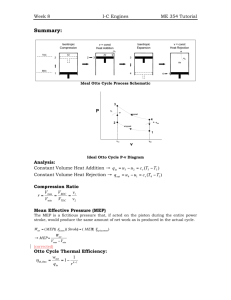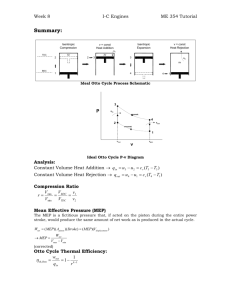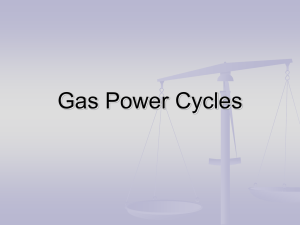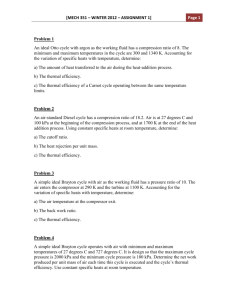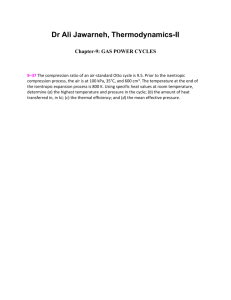and (c )
advertisement
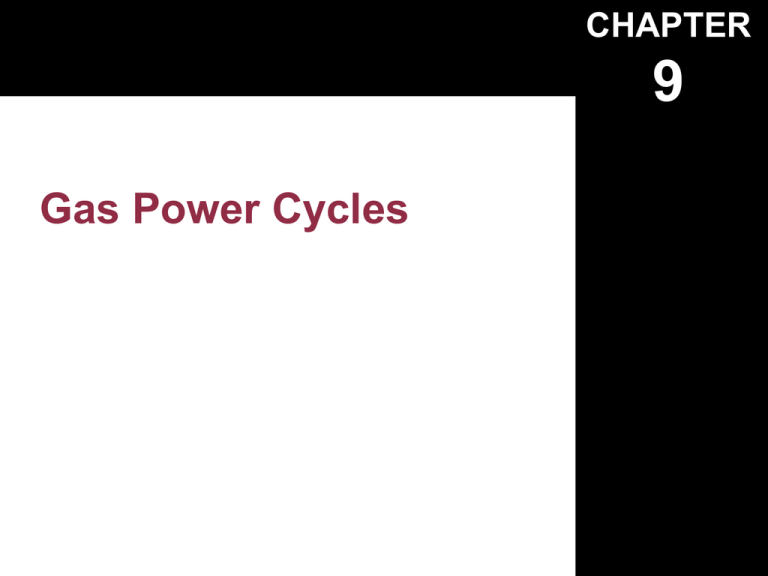
CHAPTER 9 Gas Power Cycles 9-1 Basic Considerations in the Analysis of Power Cycles Air Standard Cycles The Spark Ignition Engine Copyright © The McGraw-Hill Companies, Inc. Permission required for reproduction or display. FIGURE 9-1 Modeling is a powerful engineering tool that provides great insight and simplicity at the expense of some loss in accuracy. General classes of engines • Reciprocating internal combustion engines. • Reciprocating compressors • Reciprocating steam engines Single vs. double action engines Single action reciprocating engine. Double action reciprocating engine. Indicator diagrams An analog instrument that measures pressure vs. Displacement in a reciprocating engine. The graph is in terms of P and V. p Area is proportional to the work done per cycle V Copyright © The McGraw-Hill Companies, Inc. Permission required for reproduction or display. FIGURE 9-2 The analysis of many complex processes can be reduced to a manageable level by utilizing some idealizations. Copyright © The McGraw-Hill Companies, Inc. Permission required for reproduction or display. FIGURE 9-6 P-v and T-s diagrams of a Carnot cycle. 9-2 The Caront Cycle and Its Value in Engineering Copyright © The McGraw-Hill Companies, Inc. Permission required for reproduction or display. FIGURE 9-7 A steady-flow Carnot engine. Copyright © The McGraw-Hill Companies, Inc. Permission required for reproduction or display. FIGURE 9-8 T-s diagram for Example 9–1. 9-3 Air Standard Assumptions • The working fluid is air, which continuously circulates in a closed loop and always behaves as an ideal gas. • All the processes that make up the cycle are internally reversible. • The combustion process is replaced by a heataddition process from an external source. • The exhaust process is replaced by a heat-rejection process that restores the working fluid to its initial state. 9-4 An Overview of Reciprocating Engines Air Standard Cycles The Spark Ignition Engine Copyright © The McGraw-Hill Companies, Inc. Permission required for reproduction or display. FIGURE 9-10 Nomenclature for reciprocating engines. Copyright © The McGraw-Hill Companies, Inc. Permission required for reproduction or display. FIGURE 9-11 Displacement and clearance volumes of a reciprocating engine. Copyright © The McGraw-Hill Companies, Inc. Permission required for reproduction or display. FIGURE 9-12 The net work output of a cycle is equivalent to the product of the mean effective pressure and the displacement volume. Indicator Diagrams Work per cycle is represented in terms of a mean effective pressure and the displacement. p MEP = Mean effective pressure V X = Displacement Indicator Diagrams To compute the work per cycle, use the MEP and the displacement. Work = MEP x A x Displacement. MEP = kiY, where ki is a constant Y = the average ordinate on the indicator diagram. X = displacement A = area of cylinder heat. Work kiYA Ideal indicator diagram Spark ignition engine - The Otto cycle p d c e a b V Displacement Clearance volume Processes: a-b Intake b-c Compression c-d Combustion (spark ignited) d-e Power Stroke e-f Gas Exhaust b-a Exhaust Stroke Copyright © The McGraw-Hill Companies, Inc. Permission required for reproduction or display. FIGURE 9-13 Actual and ideal cycles in spark-ignition engines and their P-v diagrams. Copyright © The McGraw-Hill Companies, Inc. Permission required for reproduction or display. FIGURE 9-14 Schematic of a twostroke reciprocating engine. The spark ignition engine The Otto cycle The Otto cycle The air standard Otto cycle approximates the automotive internal combustion engine and aircraft engines. Assume a quasistatic process, isentropic compression, and isentropic exhaust. p 4 s = Constant 3 5 1 6 2 Displacement V The Otto cycle s = Constant 4 T p 4 3 3 5 1 6 2 P-V diagram for the actual variable mass system. 5 V 2 6 V = Constant This is the T-s diagram for the fixed mass system. s The air-standard Otto cycle Real Process • 1-2 Intake of fuel/air mixture at P1 • 2-3 Compression to P3 • 3-4 Combustion, V = cons. and increasing P • 4-5 Expansion • 5-6 Exhaust at constant V and falling pressure • 6-1Exhaust at P1 Air Cycle Approximation (Constant mass, closed internally reversible, cycle) • 2-3 Isentropic compression • 3-4 Heat addition at constant volume • 4-5 Isentropic expansion • 5-6 Heat rejection at constant volume The reversible Otto cycle • Internally reversible processes • Constant specific heats – k = Cp/Cv = Constant • Polytropic compression and expansion, PVk = Const. • Treat air as an ideal gas. Thermodynamic analysis for the reversible Otto cycle T QH 4 QC 5 QH C v (T4 T3 ) QL C v (T5 T6 ) 3 2 6 V = Constant s QH QC T5 T6 1 QH T4 T3 (1) s3 4 s56 s3 4 Thermodynamic analysis for the air-standard Otto Cycle Qrev Cv dt T T path 3 4 T4 s3 4 Cv ln , T3 T4 T5 (2) T3 T6 s56 T6 Cv ln T5 T4 T5 T3 T6 s 2 s3 Thermodynamic Analysis for the air-standard Otto Cycle T3 v 2 T2 v3 T4 v5 T5 v 4 k 1 k 1 Thermal efficiency T4 T5 T3 T6 T6 1 T3 v6 rv v3 T4 T3 T5 T6 T3 T6 v3 1 v6 1 r 1 k v 1 k Thermal efficiency v6 rv v3 1 rv 1 k Key assumptions: (1) Internally reversible processes (2) Constant specific heats Important consequence: (1) Efficiency is independent of working fluid (2) Efficiency independent of temperatures Efficiency of Air Standard Otto Cycle k = 1.3 = Cp/Cv QH T 4 3 5 2,6 WNET QC s rv Air Standard Otto Cycle 0.8 0.7 0.6 Efficiency 0.5 k = 1.4 0.4 k = 1.3 0.3 0.2 0.1 0 1 2 3 4 5 6 7 8 9 10 11 12 13 14 15 16 17 18 19 20 21 22 23 24 25 Pressure Ratio, Pv Se ri es 1 Copyright © The McGraw-Hill Companies, Inc. Permission required for reproduction or display. FIGURE 9-16 Thermal efficiency of the ideal Otto cycle as a function of compression ratio (k = 1.4). Copyright © The McGraw-Hill Companies, Inc. Permission required for reproduction or display. FIGURE 9-18 The thermal efficiency of the Otto cycle increases with the specific heat ratio k of the working fluid. The Otto cycle with real gases • Variable specific heats. • Efficiency based on internal energies obtained from the gas tables which take into account variable specific heats. u5 u6 1 u 4 u3 Q (r , T , H v 2 T QH 4 QC 5 3 mTOT ) 2,6 V = Constant s 9-6 Diesel Cycle: Air Standard Cycles The Compression Ignition Engine The compression ignition engine - the Diesel cycle Air Standard Compression Ignition Engine - The Diesel cycle • An IC power cycle useful in many forms of automotive transportation, railroad engines, and ship power plants. • Key assumptions are, – Constant specific heats, the ideal gas, and internally reversible processes. Ideal Indicator Diagram Compression Ignition Engine p c d e a b V Displacement Clearance volume Processes: a-b Intake b-c Compression c-d Combustion d-e Power Stroke e-f Gas Exhaust b-a Exhaust Stroke Ideal Indicator Diagram Compression Ignition Engine p a b c e d V Displacement Clearance volume Processes: a-b Combustion (P = Const.) b-c Expansion (s = Const) c-d Exhaust (V = Const) d-e Exhaust (P = Const) e-d Intake (P = Const) d-a Compression (s = Const) Copyright © The McGraw-Hill Companies, Inc. Permission required for reproduction or display. FIGURE 9-21 T-s and P-v diagrams for the ideal Diesel cycle. Advantages of the Diesel Cycle • Eliminates pre-ignition of the fuel-air mixture when compression ratio is high. • All heat transfer to a constant mass system. The air-standard compression ignition engine T p = Constant b a QH Win QC Wout c V = Constant d s T p = Constant a b QH QC d Thermal efficiency of the airstandard Diesel cycle c V = Constant s QC 1 QH QH C p Tb Ta QC Cv (Tc Td ) Cv (Tc Td ) (Tc Td ) 1 1 C p (Tb Ta ) k (Tb Ta ) Key parameters for the Diesel cycle p a Compression v Ratio rv b c e d V Displacement Clearance volume d va Expansion Ratio vc re vb Cut Off Ratio b c a v r v Thermal efficiency p 1 r 1 1 k 1 rv k rc 1 c k c a b e d V Displacement Clearance volume p a b Air-standard Diesel cycle c d V e Displacement Thermal Efficiency 1 rck 1 1 k 1 rv k rc 1 Clearance volume vb Cut Off Ratio: rc va vd Compression Ratio: rv va Expansion Ratio: vc re vb Important features of the Diesel cycle • At rc = 1, the Diesel and Otto cycles have the same efficiency. – Physical implication for the Diesel cycle: No change in volume when heat is supplied. – A high value of k compensates for this. • For rc > 1, the Diesel cycle is less efficient than the Otto cycle. Copyright © The McGraw-Hill Companies, Inc. Permission required for reproduction or display. FIGURE 9-22 Thermal efficiency of the ideal Diesel cycle as a function of compression and cutoff ratios (k = 1.4). Efficiency Comparisons (Approximate) rc > 1 rv Effect of variable specific heats • Efficiency is based on internal energies and enthalpies obtained from the gas tables which take into account variable specific heats. u a ub 1 ha hb Key terms and concepts Air-standard Diesel Cycle Expansion ratio Pressure ratio Cut of ratio Compression ignition Comparison of the Otto and Diesel cycles Comparison of the Otto and Diesel cycles Comparison No. 1: (a) Same inlet state (P,V) (b) Same compression ratio, rv (c) Same QH Key factor: Constant volume heat addition of the Otto cycle vs. constant pressure heat addition of the Diesel cycle. p c b Otto cycle with a specified inlet condition at “a” with a given compression ratio rv = va/vb d a Displacement V p c b Otto and Diesel cycles with same compression inlet conditions at “a” and the same compression ratio, rv. c* d* d a Displacement V p c b c* d* d a Diesel Cycle k 1 rc 1 1 k 1 rv k rc 1 V Otto Cycle 1 r 1 k v First Law analysis of the heat addition process dU Q W Otto: Heat addition with V = 0 in process b c. W = 0, and P and T increase Diesel: Heat addition with P = Constant in process b c*. dW > 0, and P and T lower that in the Otto cycle. V = Const. T Tc Tc* c Otto Cycle c* P = Const. Diesel Cycle b d* a d s T-s diagrams for equal heat addition T Tc Tc* c c* QH b a d* d s QH,Otto = QH,Diesel The areas under the process paths b c and b c* are equal under the assumption of equal heat addition, QH. Efficiency comparisons T Tc Tc* c c* When QH and rv are the same for both d* cycles, b a OTTO DIESEL d s QC,Otto < QC,Diesel Comparison of the Otto and Diesel cycles Comparison No. 2: (a) Same inlet state (P,V) (b) Same maximum P (c) Same QH Comparison No. 2 is more practical when the “knocking” effect is considered. In the Otto cycle, about 11 atm are needed to achieve combustion with engine knock. T Diesel Cycle c c* Otto Cycle b* b a d d* V = Const. P = Const. s DIESEL OTTO Gas Power Systems - 3 The Dual Cycle The Dual cycle • The dual cycle is designed to capture capture some of the advantages of both the Otto and Diesel cycles. • It it is a better approximation to the actual operation of the compression ignition engine. QH,P p b QH,V The Dual cycle c s = Constant a d QC,V e V Copyright © The McGraw-Hill Companies, Inc. Permission required for reproduction or display. FIGURE 9-23 P-v diagram of an ideal dual cycle. p b QH,P c QH,V a d e QC,V V C v (Td Te ) 1 CV (Tb Ta ) C P (TC Tb ) (Td Te ) 1 (Tb Ta ) k (TC Tb ) b QH,P c QH,V a d e V Ve rv Va Vc rc Vb Pb rP Pa r r 1 1 1 k 1 rv rp 1 krp (rc 1) k p c Gas Power Systems - 4 The Gas Turbine Overview • Gas Turbines – The Carnot cycle as an “air standard” cycle • The Ericcson Cycle • The Brayton Cycle – The standard cycle – The reheat cycle – Inter-cooling The modern gas turbine cycle • Long-haul automotive power. • Large aircraft flight envelopes • Commercial aircraft • Altitude (30,000 to 40,000 ft) • Long range and low specific fuel consumption (sfc) • Moderate speed and thrust The modern gas turbine cycle • Military aircraft • High altitude ( > 40,000 ft) • Moderate range and high specific fuel consumption (sfc) • High speed and large thrust • Relevant cycles – The Ericsson and Brayton cycles General features of the aircraft gas turbine engine Combustor Fuel Intake Air Compressor Turbine Exhaust Section Compressor Drive Shaft, Wcomp The air-standard turbine cycle • Open system modeled as a closed system - fixed with fixed mass flow. • Air is the working fluid. • Ideal gas assumptions are applied. • Approximate the combustor as the high temperature source. • Internally reversible processes. Ideal gas power cycles Air Standard Carnot Cycle Air Standard Ericcson Cycle Air Standard Brayton Cycle Air-standard Carnot cycle Air-standard Carnot cycle Employ the same assumptions as for the air-standard turbine cycle. T QH p1 p4 P1 P2 , P3 P4 TC T3 1 1 TH T1 p2 P1 1 P4 p3 QC s 1 k V4 1 V1 k 1 k P2 1 P3 V3 1 V2 1 k (1 k ) k Limitations of the air-standard Carnot cycle • Heat addition at constant temperature is difficult and costly. – Work is required because fluid expands. • Heat addition is limited because a large change in volume would imply a low mean pressure in the heat addition process. – Frictional effects might become too great if the mean pressure is too low. Copyright © The McGraw-Hill Companies, Inc. Permission required for reproduction or display. FIGURE 9-26 T-s and P-v diagrams of Carnot, Stirling, and Ericsson cycles. Copyright © The McGraw-Hill Companies, Inc. Permission required for reproduction or display. FIGURE 9-27 The execution of the Stirling cycle. Air-standard Ericsson cycle Copyright © The McGraw-Hill Companies, Inc. Permission required for reproduction or display. FIGURE 9-28 A steady-flow Ericsson engine. The air-standard Ericsson cycle • Constant pressure heat addition and rejection • Constant temperature compression and expansion Qb-c p T = Constant c b Qa-b Qc-d a Qd-a d v Qb-c p b T = Const. c Qa-b The Air Standard Ericcson Cycle Qc-d a Qd-a d v P = Const. T Qc-d c d Qb-c Qd-a b Qa-b a s p Qb-c T = Const. b Thermal Efficiency Ericcson Cycle c Qa-b Qc-d Wa-b a Qd-a d Wc-d v WNET Wc d Wa b Q Added Qb c Qc d The Brayton cycle The Brayton Cycle • Modern gas turbines operate on an open Brayton cycle. – Ambient air is drawn at the inlet. – Exhaust gases are released to the ambient environment. • The air standard Brayton cycle is a closed cycle. – All processes are internally reversible. – Air is the working fluid and assumed an ideal gas. General features of the aircraft gas turbine engine Combustor Exhaust Gases & Work Output, Wturb Fuel Intake Air Compressor Turbine Compressor Drive Shaft, Wcomp The open, actual cycle for the gas turbine. QH The closed, air standard cycle for the gas turbine. WCOMP WTURB QL The gas turbine processes • • • • Isentropic compression to TH Constant pressure heat addition at TH Isentropic expansion to TC Constant pressure heat rejection at TC QH 2 Air Standard Brayton Cycle 3 WCOMP WTURB 1 4 QL p QH 2 3 S = Constant 1 QC 4 Vv p QH 2 3 s = Constant 1 Air Standard Brayton Cycle QC 4 VV Vv T 3 QH 2 4 1 s1 = s2 p2 = p3 p1 = p4 QC s3 = s4 s 3 T QH p2 = p3 WOUT WIN 2 4 1 Thermal efficiency of the ideal Brayton cycle p1 = p4 QC s WOUT Win (h3 h4 ) h2 h1 QH h3 h2 3 T QH Thermal Efficiency Ideal Brayton Cycle p2 = p3 WOUT WIN 2 4 1 p1 = p4 QC For an ideal gas, h-h0 = Cp(T - T0). The compression and expansion process are polytropic with constant k. s P2 1 P1 (1 k ) k Cycle efficiency • Ideal gas assumptions apply. • All processes internally reversible – Compressor and turbine efficiency are each 100%. • Assume fuel added in the combustor is a small percent (mass or moles) of total flow, and thus air properties provide a good estimate of cycle performance. Gas Power Systems - 5 Real Turbine Performance Overview • Internally irreversible Brayton cycles – Case study • Real turbine performance Internally irreversible Brayton cycles Real cycle analysis - Brayton cycle • Internal irreversibility arises in each process of the open cycle. • Compression (compressor efficiency) • Heat addition • Expansion (turbine efficiency) Internal irreversibility will lower work output and decrease thermal efficiency. Greater entropy production will also result. 2 3 1 4 p2 = p3 T,h 3 4 2 p1 = p4 1 s 2 s1 s3 = s4 s4 s Case Study Case study Given: Turbine and compressor efficiencies of 80%, and the operating data as given below. No internal irreversibility in the combustor. Find: For the actual cycle, the thermal efficiency, the ratio of Wcomp/Wturb and entropy production. c T b’ b b’ QH c d d’ WIN d’ a a s QC WOUT State a b b’ c d d’ T P h S0 (R) (p sia) (Btu / lbm ) (Btu / lbm R) 530 881 967 1700 1059 1192 15 90 90 90 15 15 126.7 211.6 232.7 422.6 255.7 289.3 0.5963 0.7191 0.7421 0.8876 0.7647 0.7946 Note: Values of h and so are from the gas tables, and all initial data are supplied here but this is not necessarily the case in practice. Process Calculations Process a-b a-b’ b’-c c-d c-d’ d’-a NET Note: h Q (Btu/lbm) (Btu/lbm) (Btu/lbm) (Btu/lbmR) 84.9 106 189.9 -166.9 -133.3 -162.6 0 -84.9 -106 0 166.9 133.3 0 27.3 0 0 189.9 0 0 -162.6 0 0 0.0230 0.1455 0 0.0299 -.1983 0 si j s o i j TURB s W Pj R ln Pi h hs , COMP hs h The pressure ratios for the isentropic and actual processes are the same, and therefore s = so. Thermal Efficiency and Work Ratio CYCLE Wcomp Wturb Wnet 133.3 106 27.3 0.144 Qb ' c 189 189 106 0.795 133.3 Notice that here we have a high ratio of the work of compression to that of expansion, which is typical in gas turbine systems. The key variable is the turbine inlet temperature, Tc, and this is to be made as large a possible. Tc is limited by the material and turbine blade cooling capability. Entropy Production Process Q (Btu/lbm) a-b a-b’ b’-c c-d c-d’ d’-a NET 0 0 189.9 0 0 -162.6 27.3 s Q/T 0 0.0230 0.1455 0 0.0299 -0.1983 0 0 0 0.1455 0 0 -0.1983 -0.0528 (Btu/lbm-R) (Btu/lbm-R) (Btu/lbm-R) 0 0.0230 0 0 0.0299 0 0.0529 The entropy production rates are based on the application of the entropy balance for an open system to each process in the cycle. The heat addition and rejection processes are at the high and low temperatures respectively. Thus, these processes produce an entropy production from the external heat transfer process that is not included in the above calculations. The Carnot Efficiency for the Cycle TC 530 Carnot 1 1 TH 1700 0.68 0.144 QH, TH QC, TC (General cycle representation) Here, the difference in the efficiency calculations indicates a high level of external entropy production. p2 = p 3 Efficiency Curves T,h 4 2 TURB COMP 1 3 p1 = p 4 0.9 0.25 1 0.8 0.7 0.1 2 4 Pressure Ratio, p2/p1 s’2 S1 = S2 S3 = S4 s’4 s Brayton cycle efficiency is greatly dependent on the efficiencies of the turbine and compressor. The curves at the left are approximate. Copyright © The McGraw-Hill Companies, Inc. Permission required for reproduction or display. FIGURE 9-29 An open-cycle gas-turbine engine. Copyright © The McGraw-Hill Companies, Inc. Permission required for reproduction or display. FIGURE 9-30 A closed-cycle gas-turbine engine. Copyright © The McGraw-Hill Companies, Inc. Permission required for reproduction or display. FIGURE 9-31 T-s and P-v diagrams for the ideal Brayton cycle. Copyright © The McGraw-Hill Companies, Inc. Permission required for reproduction or display. FIGURE 9-32 Thermal efficiency of the ideal Brayton cycle as a function of the pressure ratio. Gas Power Systems - 6 Cycle Improvements Cycle Improvements • Regeneration – Reduces heat input requirements and lowers heat rejected. • Inter-cooling – Lowers mean temperature of the compression process • Reheat – Raises mean temperature of the heat addition process Copyright © The McGraw-Hill Companies, Inc. Permission required for reproduction or display. FIGURE 9-33 For fixed values of Tmin and Tmax , the net work of the Brayton cycle first increases with the pressure ratio, then reaches a maximum at rp = (Tmax /Tmin) k/[2(k – 1)], and finally decreases. Copyright © The McGraw-Hill Companies, Inc. Permission required for reproduction or display. FIGURE 9-36 The deviation of an actual gasturbine cycle from the ideal Brayton cycle as a result of irreversibilities. The Brayton cycle with regeneration Copyright © The McGraw-Hill Companies, Inc. Permission required for reproduction or display. FIGURE 9-38 A gas-turbine engine with regenerator. QH The standard Brayton cycle shown as an open cycle. 2 3 1 Regeneration is accomplished by preheating the combustor air with the exhaust gas from the turbine. WIN 4 WOUT 5 QH 2 1 3 WCOMP 4 WTURB T,h QH 3 x 4 2 y 1 Internal heat transfer, States 2 - x. QC s The maximum benefit of regeneration is obtained when the exhaust temperature Ty is brought to temperature T2 by the regenerative heat exchanger. T,h QH 3 The ideal regenerator x 4 The ideal regenerator will heat the combustion air up to T4 2 y 1 QC s CYCLE (h2 h1 ) 1 h3 h4 T,h QH 3 The actual regenerator x x y 2 y 1 QC 4 Actual internal heat transfer takes place between States 2 - x’. The effectiveness of the regenerator is the actual heat transfer divided by the maximum possible heat transfer. s C p (Tx T2' ) (Tx T2 ) C p (T4 T2 ) (T4 T2 ) T,h QH 3 Thermal efficiency Regeneration reduces net heat input at the high temperature. x x y 2 4 y 1 QC s cycle (h3 h4 ) (h2 h1 ) h3 hx Copyright © The McGraw-Hill Companies, Inc. Permission required for reproduction or display. FIGURE 9-39 T-s diagram of a Brayton cycle with regeneration. Copyright © The McGraw-Hill Companies, Inc. Permission required for reproduction or display. FIGURE 9-40 Thermal efficiency of the ideal Brayton cycle with and without regeneration. The Brayton cycle with inter-cooling The standard Brayton cycle with on stage of intercooling 7 QH WCOMP 1 5 6 3 WTURB 4 3 T 7’ 7 6 5 5’ 4 4’ 1 s One stage of inter-cooling with turbine and compressor inefficiencies. Copyright © The McGraw-Hill Companies, Inc. Permission required for reproduction or display. FIGURE 9-42 Comparison of work inputs to a single-stage compressor (1AC) and a twostage compressor with intercooling (1ABD). Copyright © The McGraw-Hill Companies, Inc. Permission required for reproduction or display. FIGURE 9-43 A gas-turbine engine with twostage compression with intercooling, twostage expansion with reheating, and regeneration. Copyright © The McGraw-Hill Companies, Inc. Permission required for reproduction or display. FIGURE 9-44 T-s diagram of an ideal gas-turbine cycle with intercooling, reheating, and regeneration. Copyright © The McGraw-Hill Companies, Inc. Permission required for reproduction or display. FIGURE 9-45 As the number of compression and expansion stages increases, the gas-turbine cycle with intercooling, reheating, and regeneration approaches the Ericsson cycle. The Brayton cycle with reheat 3 T,h QH Q23 Q45 4 5 6 2 1 Qc Q61 s The re-heating of the fluid at an intermediate pressure raises the enthalpy input to the cycle without raising the temperature of the external thermal reservoir. Example This example compares several modifications to the basic Brayton cycle: multi-stage compression and expansion with reheat, inter-cooling and regeneration. Description: In an air-standard gas turbine engine, air at 60o F and 1 atm enters the compressor with a pressure ratio of 5:1. The turbine inlet temperature is 1500o F, and the exhaust pressure is 1 atm. Determine the ratio of turbine work to compressor work and the thermal efficiency under the following operating conditions. Operating conditions: (a) The engine operates on an ideal Brayton cycle. (b) The adiabatic efficiency of the turbine and compressor are 0.83 and 0.93, respectively. (c ) The conditions of (b) hold and a regenerator with an effectiveness of 0.65 is introduced. Operating conditions: (d) The conditions of (b) and (c ) hold, and an inter-cooler that cools the air to 60o F at a constant pressure of 35 psia is added. (e) The inter-cooler is removed and a re-heater the heats the fluid to 1500o F at a constant pressure of 35 psia is added. (f) The conditions of (e) hold and the intercooler of (d) is put back. Assumptions: (1) All cycles operate on the air-standard basis. (2) Ideal gas (3) Constant specific heats; k = constant, Cp = 0.24 BTU/lbm-R, k = 1.40 = constant. (4) Internally reversible processes except where isentropic efficiency (adiabatic efficiency) is less than one. (5) 1 atm = 14.7 psia. Solution: (a) The engine operates as an ideal Brayton cycle. k 1 k 3 T T4 P4 T3 P3 h3 4 C p T3 4 4 2 1 s State D ata State 1 2 3 4 h1 2 C p T1 2 P (psia) 14.7 73.5 73.5 14.7 T (R) 520 825 1960 1237 Process quantities Process Quantities h BTU/Lbm Q BTU/lbm 1-2 2-3 3-4 4-1 Total 73.1 272.4 -173 -172 0.5 (~0) 0 272.4 0 -172 100.32 Process quantities W3 4 h3 4 C p T3 T4 173 BTU lbm W1 2 h1 2 73.1 BTU lbm Wturbine W3 4 173 2.37 Wcompressor W1 2 73.1 Wnet W3 4 W1 2 h23 h1 2 cycle Q2 3 Q2 3 h23 173 73.1 0.367 (0.24)(1960 825) (b) The adiabatic efficiency of the compressor and turbine are 0.83 and 0.92 respectively. T k 1 k T4 P4 T3 P3 h3 4 C p T3 4 3 2’ 2 4 4’ 1 s h1 2 C p T1 2 T 0.92, comp 0.83 State D ata State 1 2 3 4 P (psia) 14.7 73.5 73.5 14.7 Ws ,1 2 T2 T1 comp W1 2 T2 T1 T2 T1 T2 T1 887 R T (R) 520 825 1960 1237 comp turb W3 4 T4 1295 R W s , 3 4 State D ata State 1 2’ 3 4’ P (psia) 14.7 73.5 73.5 14.7 T (R) 520 887 1960 1295 W3 4 h3 4 C p T3 T4 159.5 BTU lbm W1 2 h1 2 88.8 BTU lbm Wturbine W3 4 159.5 1.81 Wcompressor W1 2 88.8 Wnet W3 4 W1 2 h3 4 h1 2 cycle Q23 Q23 h23 159.5 88.8 0.28 (0.24)(1960 887) (c) The conditions of (b) hold, and a regenerator with an effectiveness of 0.65 is introduced. k 1 k 3 T 2’ 2 x 4’ y 1 s T4 P4 T3 P3 h3 4 C p T3 4 h1 2 C p T1 2 (Tx T2 ' ) 0.65 (T4 ' T2 ' ) Tx T2 T4 T2 1052 R T 0.92 comp 0.83 State D ata State 1 x’ 3 4’ P (psia) 14.7 73.5 73.5 14.7 T (R) 520 1052 1960 1295 W3 4 h3 4 C p T3 T4 159.5 BTU lbm W1 2 h1 2 88.8 BTU lbm Wturbine W 159.5 3 4 1.81 Wcompressor W1 2 88.8 Wnet W3 4 W1 2 h3 4 h1 2 cycle Q x 3 Q x 3 hx3 159.5 88.8 0.37 (0.24)(1960 1052) (d) The conditions of (b) and (c ) hold, and an inter-cooler that cools the air to 60o F at 35 psia is added. 3 T P = 35 psia x 7’ 520 R 6 5’ y 4’ 1 s 3 T P = 35 psia x 7’ 520 R 6 5’ y 1 s 4’ Compute T5’ ,T7’, and the actual s temperature between state 7’ and x due to regeneration (7”). State D ata State P (psia) 14.7 35 35 14.7 73.5 73.5 73.5 73.5 14.7 73.5 14.7 1 5 5’ 6 7 7’ 7” 3 4’ x y k 1 k T5 P5 T1 P1 T5 667 R T5 T1 T (R) 520 667 697 520 643 668 616 1960 520 1295 888 1 T5 T1 T 3 P = 35 psia 7’ 6 x 5’ 4’ W3 4 159.5 BTU / lbm W15 W67 78 BTU / lbm y 1 s Wsturbine 2.04 Wcompressor Wnet 0.38 C p (T3 T7 ) (e) Eliminate inter-cooling but add one stage of reheat to 1500o F. 0.38 (f) Combine parts (d) and (e). 0.40 Wturbine 2.28 WCompressor Summary of results: (a) Ideal Cycle (b) Actual Basic Cycle (c) Actual Basic Cylce and Regenerator ( = 0.65) (d) Actual Cycle w ith Intercooling at o 35 psia to 60 F and part (c) (e) Actual Basic Cycle w ith Reheat at 35 psia and part (c) (f) Parts (c ) ,(d), and (e) combined Work Ratio 0.37 0.28 2.37 1.81 173 160 0.37 1.18 160 0.38 2.04 160 0.38 2.02 178 0.40 2.28 178 Wt/Wc Wt Copyright © The McGraw-Hill Companies, Inc. Permission required for reproduction or display. FIGURE 9-48 Basic components of a turbojet engine and the T-s diagram for the ideal turbojet cycle. [Source: The Aircraft Gas Turbine Engine and Its Operation. © United Aircraft Corporation (now United Technologies Corp.), 1951, 1974.] Copyright © The McGraw-Hill Companies, Inc. Permission required for reproduction or display. FIGURE 9-51 Energy supplied to an aircraft (from the burning of a fuel) manifests itself in various forms. Copyright © The McGraw-Hill Companies, Inc. Permission required for reproduction or display. FIGURE 9-52 A turbofan engine. [Source: The Aircraft Gas Turbine and Its Operation. © United Aircraft Corporation (now United Technologies Corp.), 1951, FIGURE 9-53Copyright © The McGraw-Hill Companies, Inc. Permission required for reproduction or display. A modern jet engine used to power Boeing 777 aircraft. This is a Pratt & Whitney PW4084 turbofan capable of producing 84,000 pounds of thrust. It is 4.87 m (192 in.) long, has a 2.84 m (112 in.) diameter fan, and it weighs 6800 kg (15,000 lbm). Photo Courtesy of Pratt&Whitney Corp. Copyright © The McGraw-Hill Companies, Inc. Permission required for reproduction or display. FIGURE 9-54 A turboprop engine. [Source: The Aircraft Gas Turbine Engine and Its Operation. © United Aircraft Corporation (now United Technologies Corp.), 1951, 1974.] Copyright © The McGraw-Hill Companies, Inc. Permission required for reproduction or display. FIGURE 9-55 A ramjet engine. [Source: The Aircraft Gas Turbine Engine and Its Operation. © United Aircraft Corporation (now United Technologies Corp.), 1951, 1974.] Copyright © The McGraw-Hill Companies, Inc. Permission required for reproduction or display. FIGURE 9-57 Under average driving conditions, the owner of a 30-mpg vehicle will spend $300 less each year on gasoline than the owner of a 20-mpg vehicle (assuming $1.50/gal and 12,000 miles/yr). Copyright © The McGraw-Hill Companies, Inc. Permission required for reproduction or display. FIGURE 9-62 Aerodynamic drag increases and thus fuel economy decreases rapidly at speeds above 55 mph. (Source: EPA and U.S. Dept. of Energy.)
